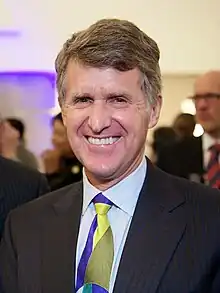Rip Rapson
Richard "Rip" Rapson (born March 16, 1952) is an American attorney and philanthropist serving as CEO of the Kresge Foundation. He began his career as a congressional aide to Donald M. Fraser during Fraser's last two terms in the United States House of Representatives. After attending Columbia Law School, Rapson joined the law firm of Leonard, Street & Deinard to practice law while also serving on the board of several organizations. In 1989, Fraser, who had become mayor of Minneapolis, appointed Rapson as his deputy mayor and, in 1993, Rapson unsuccessfully ran for mayor to succeed Fraser.
Rip Rapson | |
|---|---|
 | |
| Born | Richard Rapson March 16, 1952 Bonn, Germany |
| Nationality | American |
| Education | Pomona College (BA) Columbia University (JD) |
| Title | CEO of Kresge Foundation |
| Term | 2006–present |
| Spouse |
Gail Johnson (m. 1989) |
| Children | 2 |
| Parent |
|
| Deputy mayor of Minneapolis | |
| In office April 15, 1989 – 1993 | |
| Preceded by | Jan Hively |
After leaving the Minneapolis City Hall, Rapson became a fellow at the University of Minnesota and then was appointed president of the McKnight Foundation in Minneapolis. In 2006, he moved to the Detroit area to become CEO of the Kresge Foundation. He has led the foundation in a number of philanthropic endeavors to revitalize and rescue Detroit from bankruptcy.
Early life and education
Richard "Rip" Rapson[1] was born on March 16, 1952,[2] in Bonn, Germany,[3] to Mary and Ralph Rapson.[2] In 1954, the family moved to Minneapolis, Minnesota, where Ralph became head of the University of Minnesota School of Architecture[4] and a prolific architect in the city.[5] Mary said that their son was nicknamed Rip because he was "kicking and moving" even in the womb.[6] He has a younger brother, Thomas ("Toby"), who also became an architect at their father's architectural firm.[5][6]
At Marshall-University High School, Rip Rapson was a baseball pitcher, played basketball, tennis and learned to play the trumpet.[6] He chose to attend Pomona College in California which he believed had a good tennis team.[6] In 1974, he graduated magna cum laude from Pomona with a bachelor of arts degree in political science.[7]
Career
After college, Rapson was hired by Arvonne Fraser, who ran her husband Donald M. Fraser's offices in Washington, D.C., when he served as a United States representative from Minnesota.[6] Rapson was a congressional aide from 1974 to 1978 during Fraser's last two terms in the U.S. congress.[6][8] He worked as a liaison between Fraser's Washington office and his local district office in Minneapolis as well as contributing to the writing and passage of the Boundary Waters Canoe Area Wilderness Act of 1978 to protect the Boundary Waters Canoe Area in Minnesota.[8][9]
Rapson then graduated from Columbia Law School with a J.D.[6][10] and joined the law firm of Leonard, Street & Deinard. He became a partner at the firm[6][11] and remained there from 1981 to 1988.[12] He also served on the Library Board, the Board of Estimates and Taxation, and the boards of 13 other organizations in the city during that period.[6]
On March 14, 1989, Fraser, who had become mayor of Minneapolis, appointed Rapson as his deputy mayor, effective April 15, 1989, to succeed Jan Hively. As deputy mayor, Rapson was in charge of liaisoning with the Minneapolis City Council.[8] He was also responsible for the creation of a $400 million Neighborhood Revitalization Program and chaired its implementation committee.[9][13]
Rapson ran in the 1993 Minneapolis mayoral elections against Richard Jefferson, a member of the Minnesota House of Representatives, and Sharon Sayles-Belton, president of the city council.[14][15] Rapson relied on a grassroots campaign, receiving only 4% of his funding from political action committees.[15]
After his unsuccessful bid for mayor of Minneapolis, Rapson accepted a senior fellowship at the University of Minnesota.[11] He then served for six years as president of the McKnight Foundation in Minneapolis.[16]
In 2006, Rapson was appointed CEO of the Kresge Foundation, a foundation based in Troy, Michigan, a suburb of Detroit.[10] He was responsible for a number of large grant programs made by the foundation including a $100-million grant to bring financial stability to the Detroit Institute of Arts whose art collection was owned by the city when it went bankrupt in 2013 and was being considered for sale to cover the city's debt.[10][17] Together with Gerald Rosen, a U.S. district court chief judge, and Darren Walker of the Ford Foundation which chipped in another $125 million,[18] Rapson helped organize a "grand bargain" as proposed by Judge Rosen,[10][19] with other contributions from a number of foundations and the state of Michigan, to keep the art collection from being liquidated and help preserve pensions for city retirees, whose retirement funds were also at risk.[10][17]

Under his leadership, the foundation contributed $150 million to the implementation of the Detroit Future City plan to revitalize the city[1][20] and also spurred the development of the QLine streetcar project in downtown Detroit.[18][21] Rapson is a founding member on the board of directors of M-1 Rail, a non-profit organization which built, owns, and operates the QLine.[1][22][23] He also serves on the Detroit board of directors of the Federal Reserve Bank of Chicago.[24] As CEO of the Kresge Foundation, as of 2017, Rapson manages the organization's $3.8 billion in assets and 105 full-time employees.[25]
Bibliography
- Proescholdt, Kevin; Rapson, Rip; Heinselman, Miron L. (1995). Troubled Waters: The Fight for the Boundary Waters Canoe Area Wilderness. North Star Press of St. Cloud. ISBN 978-0-878391-00-4.
- Hession, Jane King; Rapson, Ralph; Rapson, Rip; Wright, Bruce N. (1999). Ralph Rapson: Sixty Years of Modern Design. Afton Historical Society Press. ISBN 978-1-890434-14-4.
References
- Halperin, Alex (July 6, 2015). "How Motor City Came Back From the Brink…and Left Most Detroiters Behind". Mother Jones. Retrieved April 6, 2020.
- Franklin, Robert (July 14, 1999). "Rip Rapson to take helm at McKnight". Star Tribune. pp. A1, A10. Retrieved April 6, 2020 – via Newspapers.com.
- "Sunday Q & A / Richard (Rip) Rapson". Star Tribune. May 14, 1989. pp. 2B. Retrieved April 6, 2020 – via Newspapers.com.
- Mack, Linda (April 8, 2008). "The hand of Ralph Rapson". Star Tribune. Retrieved April 6, 2020.
- Pogrebin, Robin (April 3, 2008). "Ralph Rapson, Modernist Architect, Is Dead at 93". The New York Times. Retrieved April 6, 2020.
- Parsons, Jim (August 2, 1993). "Rapson's quest to be mayor, once thought quixotic, gains momentum". Star Tribune. p. 5A. Retrieved April 6, 2020 – via Newspapers.com.
- Wood, Mark, ed. (Fall 2014). "Blaisdell Distinguished Alumni Awards for 2014: Rip Rapson" (PDF). Pomona College Magazine. p. 49. Retrieved April 6, 2020.
- McGrath, Dennis (March 15, 1989). "Fraser picks attorney Rapson as deputy, liaison to council". Star Tribune. pp. 7B. Retrieved April 6, 2020 – via Newspapers.com.
- Rapson, Rip (June 6, 2019). "Tribute: Minnesota hero instrumental in placing children and families at the core of municipal policy". The Kresge Foundation. Retrieved April 6, 2020.
- Hodges, Michael (November 5, 2015). "Rip Rapson: Visionary with a focus on Detroit". The Detroit News. Retrieved April 6, 2020.
- "Former Twin Cities Leader Aims to Revitalize Detroit". Twin Cities Business. January 15, 2013. Retrieved April 6, 2020.
- Levy, Paul (November 1, 1993). "Mayor candidate who lost in the primary now face a void in their lives". Star Tribune. p. 1E. Retrieved April 6, 2020 – via Newspapers.com.
- Nathanson, Iric (February 20, 2019). "Putting Neighborhoods 2020 in context". MinnPost. Retrieved April 6, 2020.
- Latimer, George; Bickal, Jim (November 10, 1992). "1993 Mayoral Candidates for Minneapolis". KTCA Reports. PBS. Retrieved April 6, 2020.
- Wahlberg, Adam (August 1993). "The Stealth Candidate Moves to Center Stage". Law and Politics. Vol. 8, no. 5. pp. 17–18.
- Proscio, Tony; Farber, M. A. (January 14, 2019). Embracing a City, The Kresge Foundation in Detroit: 1993-2017. Wayne State University Press. p. 113. ISBN 978-0-9839654-9-7.
- Proscio & Farber 2019, p. 51.
- Welch, Sherri (June 1, 2017). "Rip Rapson". Crain's Detroit Business. Retrieved April 6, 2020.
- Bomey, Nathan (April 25, 2016). Detroit Resurrected: To Bankruptcy and Back. W. W. Norton & Company. p. 118. ISBN 978-0-393-24892-0.
- Dolan, Matthew (January 10, 2013). "Foundation Pledges $150 Million to Detroit". Wall Street Journal. ISSN 0099-9660. Retrieved April 6, 2020.
- Walsh, Tom (January 10, 2013). "Kresge Foundation puts up money so plan won't gather dust". Detroit Free Press. pp. A9. Retrieved April 6, 2020 – via Newspapers.com.
- Lawrence, Eric D.; Zaniewski, Ann (May 21, 2019). "Wondering when QLINE will arrive? You're not alone, but new system could change that". Detroit Free Press. Retrieved April 6, 2020.
- Powell, Walter W.; Bromley, Patricia (April 14, 2020). The Nonprofit Sector: A Research Handbook, Third Edition. Stanford University Press. p. 251. ISBN 978-1-5036-1108-5.
- "Detroit Board of Directors". Federal Reserve Bank of Chicago. Retrieved April 6, 2020.
- Reindl, J. C. (August 23, 2019). "Southeast Michigan nonprofit CEO pay has jumped. Here's why". Detroit Free Press. Retrieved April 6, 2020.